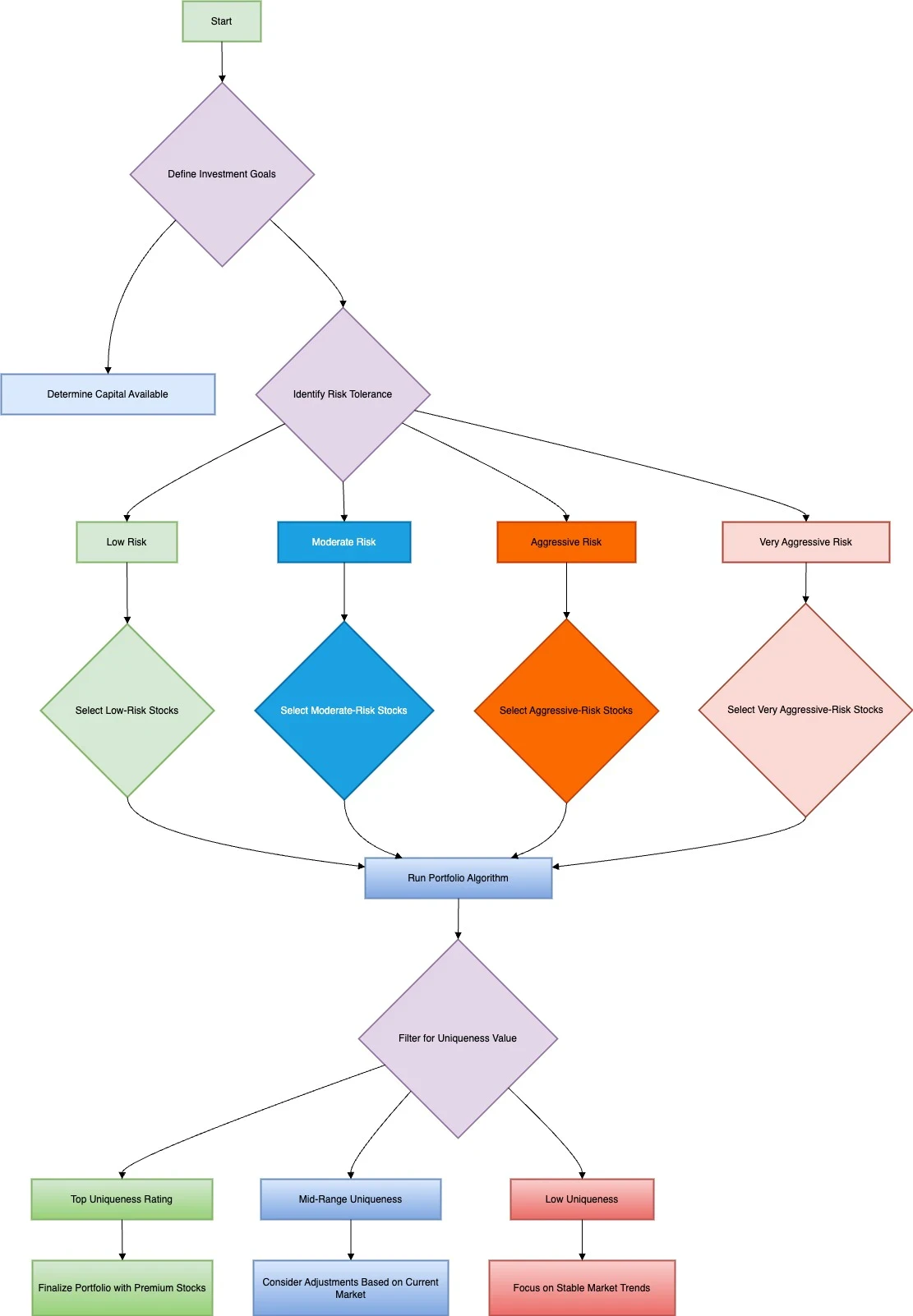Algorithm to Select Your Portfolio Based on Stock Risk Profile and Uniqueness
This article guides users in selecting an optimal portfolio aligned with their individual risk tolerance. By using Intuitive Code’s risk profile and uniqueness parameters, investors can make data-driven choices that enhance both stability and growth potential.
Understanding Stock Risk Profile in Intuitive Code's AI-Suggested Portfolio
Each stock in an AI-suggested portfolio by Intuitive Code is assigned a risk profile, accompanied by an explanation specific to that asset. This profile allows users to select stocks according to their risk tolerance, whether low-risk for steady growth or more aggressive stocks for higher returns.
Intuitive Code categorizes risk profiles as follows:
Low Risk
Moderate Risk
Aggressive Risk
Very Aggressive Risk
These values, accessible through the AI agent assigned to your product, reflect both market conditions and Intuitive Code’s proprietary analytics.
Factors Influencing Risk Profile Changes
It’s important to recognize that the risk profile for a particular stock can change over time. Influencing factors include:
Current Price (CP)
Fundamental Analysis: Factors such as earnings reports, revenue, and market performance.
Proprietary Indicators: Data-driven metrics developed by Intuitive Code for refined analysis.
Geopolitical Analytics: Consideration of market-relevant global events, political changes, and economic policy shifts.
Due to these influences, regular review of risk profiles within your portfolio is recommended, as they can shift in response to the latest market conditions.
Selecting Stocks by Risk Profile
Below is an overview of how each risk profile may align with different investment goals:
Low Risk
If your goal is steady growth with minimal volatility, focus on stocks with a low-risk profile. These assets tend to exhibit stable performance with lower price fluctuations. While low-risk stocks may not deliver high short-term returns, they generally offer greater resilience in market downturns, with favorable long-term perspectives. This selection is suitable for conservative investors looking to preserve capital with moderate growth.
Moderate Risk
Moderate-risk stocks are suited to investors willing to accept some volatility for potentially higher returns than low-risk stocks typically offer. Moderate-risk stocks balance growth and risk, making them ideal for those seeking a more dynamic portfolio that remains resilient in most market conditions. Stocks in this category may respond to short-term shifts but are less likely to exhibit the extremes seen in aggressive risk categories.
Aggressive and Very Aggressive Risk
For investors selecting aggressive and very aggressive stocks, it’s important to note that these profiles are associated with a higher likelihood of stop losses being triggered or abrupt changes in parameter values within the analytics dataset. This increased volatility presents both greater opportunities and heightened risks. However, with a disciplined approach that leverages Intuitive Code’s high-precision analytics and sound stop-loss management, investors can potentially achieve higher returns on investment (ROI) in these high-risk categories.
For these risk profiles, a disciplined approach is strongly advised. Investors are encouraged to apply core principles discussed in Intuitive Code’s Academy, particularly those related to managing stop losses, evaluating parameter shifts, and maintaining composure during periods of heightened market movement.
The Role of Uniqueness in Portfolio Selection
The uniqueness parameter, exclusive to Intuitive Code’s QMI AI, indicates how distinct a company is within its sector or industry. Stocks with a high uniqueness ranking often hold competitive advantages, such as proprietary technology, market leadership, or a strong brand. When used in conjunction with the risk profile, uniqueness can be instrumental in selecting stocks that provide an additional layer of value.
For investors seeking quality over quantity, we highly recommend prioritizing stocks with:
Uniqueness Rankings of 5 out of 5
Low to Moderate Risk Profiles
Stocks that score high on uniqueness and low on risk may offer growth potential that is both innovative and stable, ideal for building a well-rounded, resilient portfolio.
Practical Tips for Portfolio Selection
Balance Risk and Uniqueness: Use the uniqueness parameter alongside risk to filter stocks that align with your goals. Prioritize unique, low-risk stocks for a foundation of stability, and consider moderate-risk stocks for added growth.
Monitor for Risk Profile Adjustments: Since risk levels may change, periodically revisit the portfolio’s risk profile in response to shifting market factors such as fundamental analysis, geopolitical developments, and proprietary indicators.
Consult the AI Agent for Real-Time Data: The AI agent associated with your product provides up-to-date risk profiles and uniqueness ratings. Use this resource as a dynamic reference for making informed portfolio adjustments.
In summary, an optimal portfolio selection process takes into account both risk tolerance and competitive advantage. By aligning these parameters with your investment objectives, Intuitive Code’s AI analytics enable a more strategic and data-backed approach to portfolio construction. For ongoing support, we recommend consulting the AI agent regularly to track potential shifts in stock risk profiles and uniqueness values, ensuring your portfolio remains aligned with your evolving investment goals.
Flowchart for Selecting Your Portfolio Based on Risk Profile and Uniqueness
Explanation of Flowchart
Define Investment Goals: Identify the financial goals to guide the portfolio selection.
Determine Capital Available: Establish the capital for investment.
Identify Risk Tolerance: Define the risk level—low, moderate, aggressive, or very aggressive.
Select Stocks Based on Risk: Choose stocks aligned with the determined risk profile.
Run Portfolio Algorithm: Use Intuitive Code’s portfolio algorithm for optimization.
Filter for Uniqueness: Prioritize stocks based on their "Uniqueness" rating, favoring higher ratings.
Finalize Portfolio: Make adjustments or finalize the selection depending on market conditions.
This flowchart provides a structured view of the decision-making process for constructing a portfolio using Intuitive Code's AI-driven analytics and uniqueness metric.

